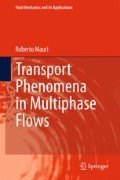Abstract
In the previous chapters we have confined ourselves to the case of forced convention, where the fluid movement is caused by an external cause, such as the movement of one of the fluid boundaries, or the pressure difference induced by a pump or by gravity. We have not considered, so far, the important case of free convection, named also natural convection, or buoyancy-driven flows, where the fluid movement is caused by the density differences due to changes of temperature or concentration of the fluid. Free convection is encountered very often in nature. For example, air heats up, as it flows past the slopes of a mountain which has been heated by the sun, so that its density decreases and consequently moves upward. This mechanism generates those updrafts that are well known to all birds and, generally, to all those who delight of gliding. Also, as the water at the surface of warm seas evaporates, its salt concentration increases, so that the water becomes heavier, sediments and is then replaced by the lighter water coming from colder seas, thus generating marine currents. The crucial aspect of free convection is that velocity and temperature (and concentration as well) are tightly coupled to one another. That means that, while in forced convection the velocity field is imposed and can be determined (almost) independently of temperature (or concentration), in free convection fluid motion is due directly to a temperature difference, so that velocity and temperature must be determined in parallel, thus making the problem much more difficult to solve. This chapter intends to be only a short introduction to the free convection problem, determining in Sect. 19.1 the governing equation and their scaling, and in Sect. 19.2 solving them in one of the very few cases where an exact solution does exist. The boundary layer theory in free convection is then explained in Sects. 19.3 and 19.4, followed by Sect. 19.5, where a few experimental correlations are presented. Finally, in Sect. 19.6, a few examples of flow with phase transition are described, where the density difference between the phases plays obviously a very important role.
Access this chapter
Tax calculation will be finalised at checkout
Purchases are for personal use only
Notes
- 1.
Note that the shear stress and the heat and mass fluxes depend also on viscosity, thermal conductivity and molecular diffusivity, which, like density, depends on temperature and solute concentration. However, these dependencies are quite less pronounced than for density.
- 2.
J.V. Boussinesq (1842–1929) was a French physicist.
- 3.
Named after Franz Grashof (1826–1893), a German engineer.
- 4.
As we have seen in Sect. 5.1, this is a consequence of the translational symmetry of the problem.
- 5.
Remember that the temperature gradient is in the longitudinal direction and therefore it is of O(1).
- 6.
This curve was obtained experimentally by Nukiyama in 1934.
- 7.
When the heat flux is progressively increased from point A, we reach the critical point C and then jump to point E; at this point, if we decrease the heat flux from point E, we reach so so-called Leidenfrost point D and then jump back to the initial A-C part of the curve.
- 8.
In fact, in most cases the tubes are placed inside a furnace, and so the heat flux is determined by the characteristics of the chemical reaction taking place in the combustion chamber.
Author information
Authors and Affiliations
Corresponding author
Rights and permissions
Copyright information
© 2015 Springer International Publishing Switzerland
About this chapter
Cite this chapter
Mauri, R. (2015). Free Convection. In: Transport Phenomena in Multiphase Flows. Fluid Mechanics and Its Applications, vol 112. Springer, Cham. https://doi.org/10.1007/978-3-319-15793-1_19
Download citation
DOI: https://doi.org/10.1007/978-3-319-15793-1_19
Published:
Publisher Name: Springer, Cham
Print ISBN: 978-3-319-15792-4
Online ISBN: 978-3-319-15793-1
eBook Packages: EngineeringEngineering (R0)

